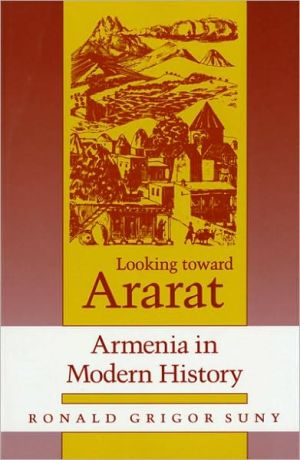

 |

|

The average rating for Looking toward Ararat: Armenia in Modern History based on 2 reviews is 4 stars.
Review # 1 was written on 2017-12-31 00:00:00 Deborah Panella Deborah PanellaArmenia rises again, and again In the mid-19th century, Armenians had already been divided for a long time. Their traditional homeland in Anatolia was split up between three empires---Russia, Iran and the Ottomans. Most people there lived either as peasants or townsmen in forgotten corners. Another large segment of the Armenians lived in distant large cities such as Istanbul, Izmir, Isfahan, or Tiflis. The two sections did not often mix. Awareness of Armenia's history, culture and even language was at an all-time low. Inspired by the struggles and movements of other peoples, mostly in Europe, the Armenian intellectuals began to build an "identity", to create a nation where none had existed for half a millennium. Strands of socialism and Marxism wove their way through the national struggle, but they always played second fiddle to the cause of the nation. Rallying around the Apostolic Church and the ancient Armenian language with its own script, but developing strong disagreements among themselves over tactics and directions, the Armenians moved towards a nation state of their own, to be located in Anatolia. Unlike the many Balkan nationalities, the Baltics, Israel, and indeed Italy and Germany too, the Armenians were doomed to failure. Taking advantage of the chaos of World War I, some nationalists demonstrated and fought for a new Armenia, to arise on the ashes of the Ottoman Empire. The idea backfired and led to genocide. The remnants of the Anatolian Armenians, if they did not flee south to Arab cities, to North America or Europe, wound up in a corner of historic Armenia that remained under control of Russia. After a two year period of independence, that Armenia became part of the Soviet Union. Suffering the vicissitudes of life in the USSR, but transformed into an urban, literate, and nationalistic society, Armenia finally re-emerged on the world stage in 1991, impoverished and embattled once again. Suny's book on Armenia in Modern History deserves high marks for trying to avoid the nationalistic slant that disfigures so many "modern histories". As he himself notes, "the field of Armenian history is marked by unquestioning nationalism, narcissism, and ethnic-pride boosting." Challenging the accepted mythology always makes interesting reading and LOOKING TOWARDS ARARAT is no exception. Suny concentrates on the Armenians of Anatolia and the Caucasus---those who lived further away from the traditional homeland appear only in passing. The book has three themes: the nature of Armenian-ness and the "idea" of Armenia, the struggle to create an Armenian state, and the transformation of the Armenian people from peasants and urbanites in diaspora to an urban, industrial, literate people living in a truncated-but-viable national state. Two issues that are also discussed are the genocide (Chap. 6) and the events that led to a) Armenia's separation from the USSR and b) the war with Azerbaijan in the 1990s. The author covers this last part in blow-by-blow detail. Other than the glaring lack of a good map, I have only praise for this book and for the author in trying to cross through what is no doubt a minefield of angry nationalist opinion. I learned a great deal and can recommend the book to anyone who is seriously interested in the topic. It isn't bedtime reading. It's academic, but still the most useful, well-written book I've found that deals with modern Armenian history. |
Review # 2 was written on 2013-06-23 00:00:00 Don Knox Don KnoxGreat |
CAN'T FIND WHAT YOU'RE LOOKING FOR? CLICK HERE!!!